Analysis of a Multiple Traffic Flow Network’s Spatial Organization Pattern Recognition Based on a Network Map
Abstract
:1. Introduction
2. Research Methodology
2.1. Study Area and Data
2.1.1. Study Area
2.1.2. Data
2.2. Construction of Networks
2.3. Theil Index
2.4. Use of Baidu Maps API to Obtain Time Distance
2.5. Weighted Average Travel Time
2.6. Community Detection Model of a Multiple Traffic Flow Network
2.6.1. Construction of Multiple Traffic Flow Networks
2.6.2. Community Detection Model
3. Results and Analysis
3.1. Overall Spatial Differentiation Characteristics of the Network
3.2. Accessibility Pattern of Multiple Traffic Flow Networks
- (1)
- The accessibility pattern based on the highway network presents a “core–edge” spatial pattern in space, and the average weighted travel time is 12.31 h. In general, the high-accessibility core area (8.60~10.08 h) is mainly concentrated in the “Two Lakes” and Hangzhou areas, radiating to the east and west wings. The medium-accessibility area (10.26~14.79 h) is mainly concentrated in the Chengdu–Chongqing metropolitan area. Due to the special topography of the Hengduan Mountains and the Yunnan-Guizhou Plateau in the western part of the Economic Belt, the low-accessibility area (18.05~24.04 h) is mainly concentrated in the Diqing Tibetan Autonomous Prefecture, Nujiang Lisu Autonomous Prefecture, and Xishuangbanna Dai Autonomous Prefecture in western Yunnan.
- (2)
- The accessibility pattern based on the railway network generally presents a spatial pattern of “strong in the east and weak in the west”, and the average weighted travel time is 13.09 h. With the advent of high-speed rail, the travel time cost between the core cities in the Yangtze River Economic Belt and the surrounding small- and medium-sized cities has been significantly reduced, dividing it into two parts: the eastern and western parts. The eastern region has a clear radiation trend to the Yangtze River Delta region, while the western region is centered on Chongqing and Guiyang and extends along the east and west sides. In general, the core areas of high accessibility (7.35~10.97 h) are mainly concentrated in the central and eastern provincial capitals, such as Wuhan, Changsha, Hefei, and Nanjing. The areas of medium accessibility (11.12~17.40 h) are mainly concentrated in the middle reaches of the Yangtze River and the urban agglomeration of Chengdu and Chongqing. Due to the special topography of the Hengduan Mountains and Yunnan-Guizhou Plateau in the western part of the Economic Belt, the railway network is relatively sparse, and the areas of low accessibility (18.04~32.08 h) are mainly concentrated in Diqing Tibetan Autonomous Prefecture, Nujiang Lisu Autonomous Prefecture, and Baoshan in western Yunnan.
- (3)
- The accessibility pattern based on the aviation network presents a spatial pattern of “time and space compression in western cities”. Compared with the sparse road and rail network, the average weighted travel time is improved to 7.4 h. In general, the high-accessibility core area (4.97~5.99 h) is mainly concentrated in provincial capitals and ethnic minority autonomous prefectures with tourist attractions. The medium-accessibility area (6.08~8.80 h) is mainly concentrated in the Yunnan-Guizhou region, of which Guizhou is affected by natural factors such as topography and landforms, it is the only province in the country where every city (state) has an airport, forming a provincial airport cluster. The low-accessibility area (9.04~11.51 h) is mainly concentrated in Tongling, Anshun City, Suzhou City, and Bengbu City in Anhui Province in the eastern region, as well as Aba Tibetan, Qiang Autonomous Prefecture, and Garze Tibetan Autonomous Prefecture in western Sichuan.
3.3. Hierarchical Structure and Effects of Network Communities
3.3.1. Hierarchical Structures of Clusters
3.3.2. Regional Effects of City Networks
3.4. Urban Cyberspace Organization Pattern
4. Conclusions and Implications
Author Contributions
Funding
Institutional Review Board Statement
Informed Consent Statement
Data Availability Statement
Acknowledgments
Conflicts of Interest
References
- Council, S. Notice of the State Council on Issuing the Development Plan for the Modern Comprehensive Transportation System during the “14th Five-Year Plan”. In China’s Foreign Economic and Trade Announcement. 2022. Available online: https://www.gov.cn/zhengce/zhengceku/2022-01/18/content_5669049.htm (accessed on 18 December 2023).
- Wang, J.; Du, D.; Jin, F. Comparison of spatial structure and linkage systems and geographic constraints: A perspective of multiple traffic flows. Acta Geogr. Sin. 2019, 74, 2482–2494. [Google Scholar]
- Liu, J.; Meng, B.; Shi, C. A multi-activity view of intra-urban travel networks: A case study of Beijing. Cities 2023, 143, 104634. [Google Scholar] [CrossRef]
- Ma, S.; Long, Y. Functional urban area delineations of cities on the Chinese mainland using massive Didi ride-hailing records. Cities 2020, 97, 102532. [Google Scholar] [CrossRef]
- Wang, J.; Xiong, M.; Huang, J. Subway accessibility under space-time constraints: A case study of Beijing. Sci. Geogr. Sin. 2022, 42, 83–94. [Google Scholar]
- Liu, X.; Liu, L.; Zou, J. Spatial and temporal analysis of urban commuting based on smart bus card data. Comput. Appl. Softw. 2021, 38, 69–74+105. [Google Scholar]
- Li, Y.; Wu, Q.; Zhang, Y.; Zhang, H.; Fang, S.; Jin, S. Spatial structure and formation mechanism of expressway traffic flow network based on space of flows: A case study of Guangdong province. Geogr. Res. 2021, 40, 2204–2219. [Google Scholar]
- Gan, D.; Guo, X.; Pan, D. Spatial coupling analysis on the county transportation accessibility and tourism economic connection in Chongqing-Hubei border areas. Geogr. Geo-Inf. Sci. 2022, 38, 137–144. [Google Scholar]
- Chen, W.; Liu, W.; Duan, X. Spatial organization evolution of railway passenger transportation in the perspective of “space of flow”: A case study of the Yangtze River Delta urban agglomeration. Geogr. Res. 2020, 39, 2330–2344. [Google Scholar]
- Fan, J.; Li, Y.; Zhang, Y.; Luo, X.; Ma, C. Connectivity and Accessibility of the Railway Network in China: Guidance for Spatial Balanced Development. Sustainability 2019, 11, 7099. [Google Scholar] [CrossRef]
- Liu, W.; Guo, J.; Wu, W.; Cao, Y. The evolution of regional spatial structure influenced by passenger rail service: A case study of the Yangtze River Delta. Growth Change 2022, 53, 651–679. [Google Scholar] [CrossRef]
- He, D.; Chen, Z.; Pei, T.; Zhou, J. The Regional and Local Scale Evolution of the Spatial Structure of High-Speed Railway Networks—A Case Study Focused on Beijing-Tianjin-Hebei Urban Agglomeration. ISPRS Int. J. Geo-Inf. 2021, 10, 543. [Google Scholar] [CrossRef]
- Li, E.; Lu, Y.; Yang, X.; Chen, Y. Spatio-temporal evolution on connection strength of global city network based on passenger flight data from 2014 to 2018. Sci. Geogr. Sin. 2020, 40, 32–39. [Google Scholar]
- Zhang, F.; Ning, Y.; Lou, X. The evolutionary mechanism of China’s urban network from 1997 to 2015: An analysis of air passenger flows. Cities 2021, 109, 103005. [Google Scholar] [CrossRef]
- Dong, Y.; Lu, Z.; Zhang, Y.; Feng, F.; Yan, Y. Deconstruction of air traffic flow network and dynamic allocation of airspace resources: A case study of Beijing-Chengdu corridor-in-the-Sky. Geogr. Geo-Inf. Sci. 2022, 38, 116–123+132. [Google Scholar]
- Yang, H.; Dobruszkes, F.; Wang, J.; Dijst, M.; Witte, P. Comparing China’s urban systems in high-speed railway and airline networks. J. Transp. Geogr. 2018, 68, 233–244. [Google Scholar] [CrossRef]
- Chen, Z.; Liang, Y.; Jin, F. Simulation of city network accessibility and its influence on regional development pattern in China based on integrated land transport system. Prog. Geogr. 2021, 40, 183–193. [Google Scholar] [CrossRef]
- Ke, W.; Xiao, B.; Xu, K.; Zeng, C. Fujian city networks spatial organization patterns based on railway passenger flow. J. Fujian Norm. Univ. (Nat. Sci. Ed.) 2021, 37, 87–98. [Google Scholar]
- Ke, w.; Chen, W.; Yang, Q. Uncovering spatial organization patterns of regional city networks from expressway traffic flow data: A case study of Jiangsu province, China. Geogr. Res. 2018, 37, 1832–1847. [Google Scholar]
- Girvan, M.; Newman, M.E.J. Community structure in social and biological networks. Proc. Natl. Acad. Sci. USA 2002, 99, 7821–7826. [Google Scholar] [CrossRef] [PubMed]
- Pons, P.; Latapy, M. Computing Communities in Large Networks Using Random Walks. Int. Symp. Comput. Inf. Sci. 2005, 3733, 284–293. [Google Scholar]
- Raghavan, U.N.; Albert, R.; Kumara, S. Near linear time algorithm to detect community structures in large-scale networks. Phys. Rev. E Stat. Nonlin. Soft Matter Phys. 2007, 76, 036106. [Google Scholar] [CrossRef] [PubMed]
- Rosvall, M.; Bergstrom, C.T. Maps of random walks on complex networks reveal community structure. Proc. Natl. Acad. Sci. USA 2008, 105, 1118–1123. [Google Scholar] [CrossRef]
- Yue, H.; Guan, Q.; Pan, Y.; Chen, L.; Lv, J.; Yao, Y. Detecting clusters over intercity transportation networks using K-shortest paths and hierarchical clustering: A case study of mainland China. Int. J. Geogr. Inf. Sci. 2019, 33, 1082–1105. [Google Scholar] [CrossRef]
- Chen, Y.; Xu, J.; Xu, M. Finding community structure in spatially constrained complex networks. Int. J. Geogr. Inf. Sci. 2015, 29, 889–911. [Google Scholar] [CrossRef]
- Zhou, H.J.; Lipowsky, R. Network Brownian Motion: A New Method to Measure Vertex-Vertex Proximity and to Identify Communities and Subcommunities. Int. Conf. Comput. Sci. 2004, 3038, 1062–1069. [Google Scholar]
- Fan, Y.; Zhan, Q.; Zhang, H.; Wu, J. A Comprehensive Regional Accessibility Model Based on Actual Routes-of-Travel: A Proposal with Multiple Online Data. Comput. Urban Plan. Manag. Smart Cities 2019, 16, 463–482. [Google Scholar]
- Wan, Y.; Liu, Y. Community detection algorithm based on geographical weighted central node distance. Geomat. Inf. Sci. Wuhan Univ. 2019, 44, 1545–1552. [Google Scholar]
- Wan, Y.; Liu, Y. DASSCAN: A Density and Adjacency Expansion-Based Spatial Structural Community Detection Algorithm for Networks. ISPRS Int. J. Geo-Inf. 2018, 7, 159. [Google Scholar] [CrossRef]
- Zhao, Y.; Yu, H. A door-to-door travel time approach for evaluating modal competition of intercity travel: A focus on the proposed Dallas-Houston HSR route. J. Transp. Geogr. 2018, 72, 13–22. [Google Scholar] [CrossRef]
- Gao, P.; Ning, Y.; He, D. Spatial Evolution and Interaction Effects of Multi-scalar UrbanNetworks in the Yangtze River Delta. Sci. Geogr. Sin. 2022, 42, 1767–1777. [Google Scholar]
- Sheng, Y.; Gou, Q.; Song, J. Innovation Linkage Network Structure and Innovation Efficiency in Urban Agglomeration: A Case of the Beijing-Tianjin-Hebei, the Yangtze River Delta and the Pearl River Delta. Sci. Geogr. Sin. 2020, 40, 1831–1839. [Google Scholar]
- Wu, S.; Zhonh, Y.; WU, Q.; MAO, W. Multi-outward connection networks of urban agglomeration: An empirical study from middle reaches of Yangtze River to Yangtze River Economic Belt. Resour. Environ. Yangtze Basin 2021, 30, 2360–2372. [Google Scholar]
- Zheng, W.; Xiong, Y.; Wang, X. Evolutionary Characteristics of Railway Flow Network Urban Agglomerations in the Middle Reaches of Yangtze River: Based on Game Overlapping Community Model. Econ. Geogr. 2022, 42, 9–18. [Google Scholar]
- Zhou, J.; Ling, C. Study on Temporal Variations of Network Connectivity and Degree Centrality in the Middle of the Yangtze River (2001–2016). Resour. Environ. Yangtze Basin 2021, 30, 544–553. [Google Scholar]
- Xiao, H.; Wang, Q.; Zhang, J. Analysis of the characteristics and influencing factors of the Inter-locked network of Chengdu-Chongqing urban agglomeration: A perspective of highway passenger transport. Shanghai Urban Plan. Rev. 2021, 2, 128–135. [Google Scholar] [CrossRef]
- Zong, H.; Huang, Y.; Hu, Y. Characteristics of Urban Networks of Chengdu-Chongqing Urban Agglomeration Based on the Passengers Flow. Areal Res. Dev. 2018, 37, 60–65+82. [Google Scholar]
- Tu, J.; Mao, K.; Kuang, R.; Li, N. A comparative analysis of the intercity passenger transport network structure of three urban agglomerations in the Yangtze River Economic Belt. World Reg. Stud. 2021, 30, 69–79. [Google Scholar]
- Wang, Q.; Cheng, Y. Characteristics and Performance of City Network from the Perspective of High- way Freight—The Case of Three Major Urban Agglomerations in China. Urban Plan. Forum 2020, 32–39. [Google Scholar] [CrossRef]
- Jin, X.; Hu, G.; Ding, H.; Ye, S.; Lu, Y.; Lin, J. Evolution of spatial structure patterns of city networks in the Yangtze River Economic Belt from the perspective of corporate pledge linkage. Growth Change 2020, 51, 833–851. [Google Scholar] [CrossRef]
- Zhao, D.; Zhang, J. Research into spatial pattern changes of Yangtze River Delta’s accessibility under the impact of high-speed railway. Resour. Environ. Yangtze Basin 2012, 21, 391–398. [Google Scholar]
- Liu, Y.; Wang, F.; Kang, C.; Gao, Y.; Lu, Y. Analyzing relatedness by toponym co-occurrences on web pages. Trans. GIS 2014, 18, 89–107. [Google Scholar] [CrossRef]
- Yen, J.Y. Finding the K Shortest Loopless Paths in a Network. Manag. Sci. 1971, 17, 712–716. [Google Scholar] [CrossRef]
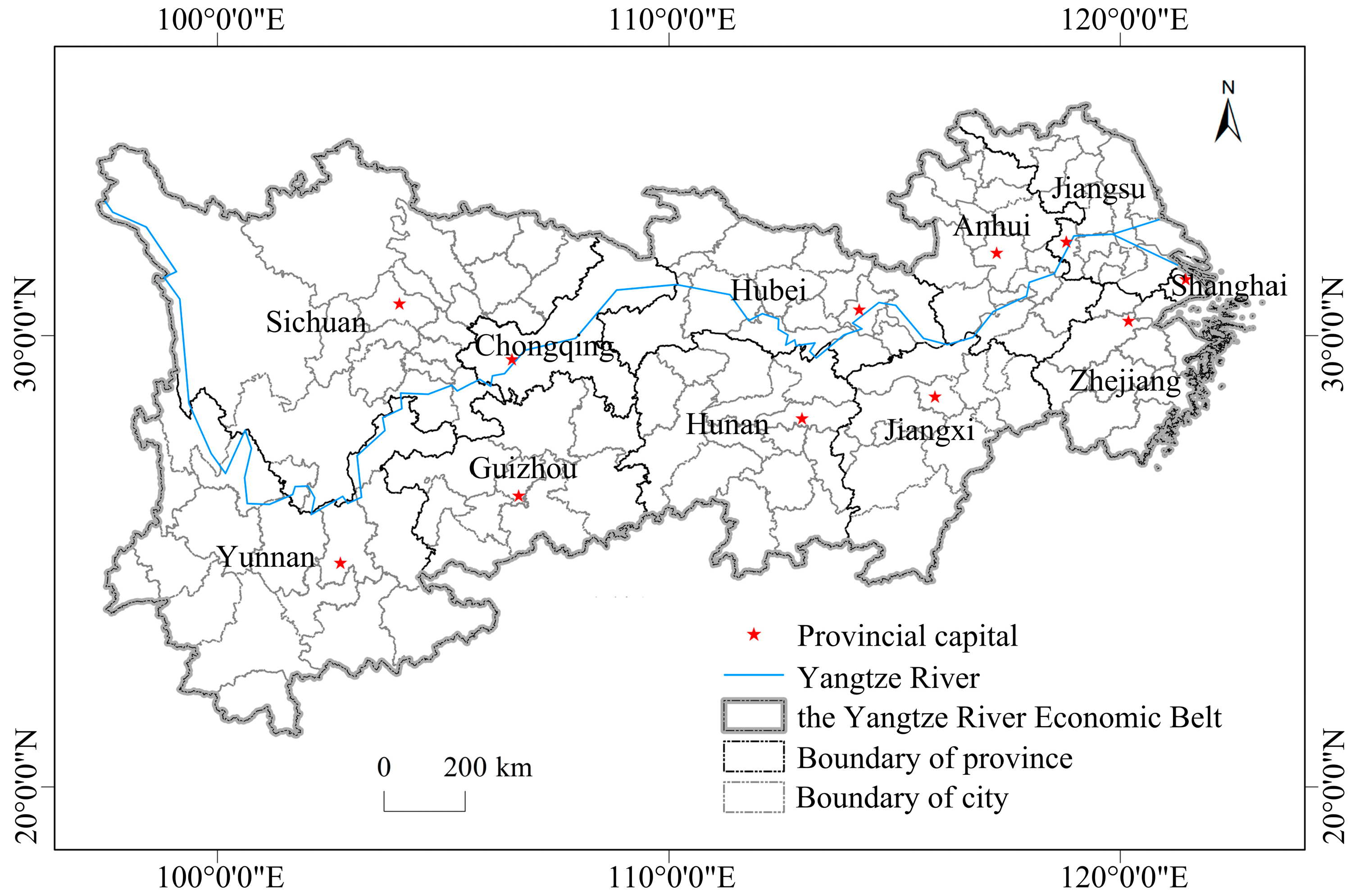
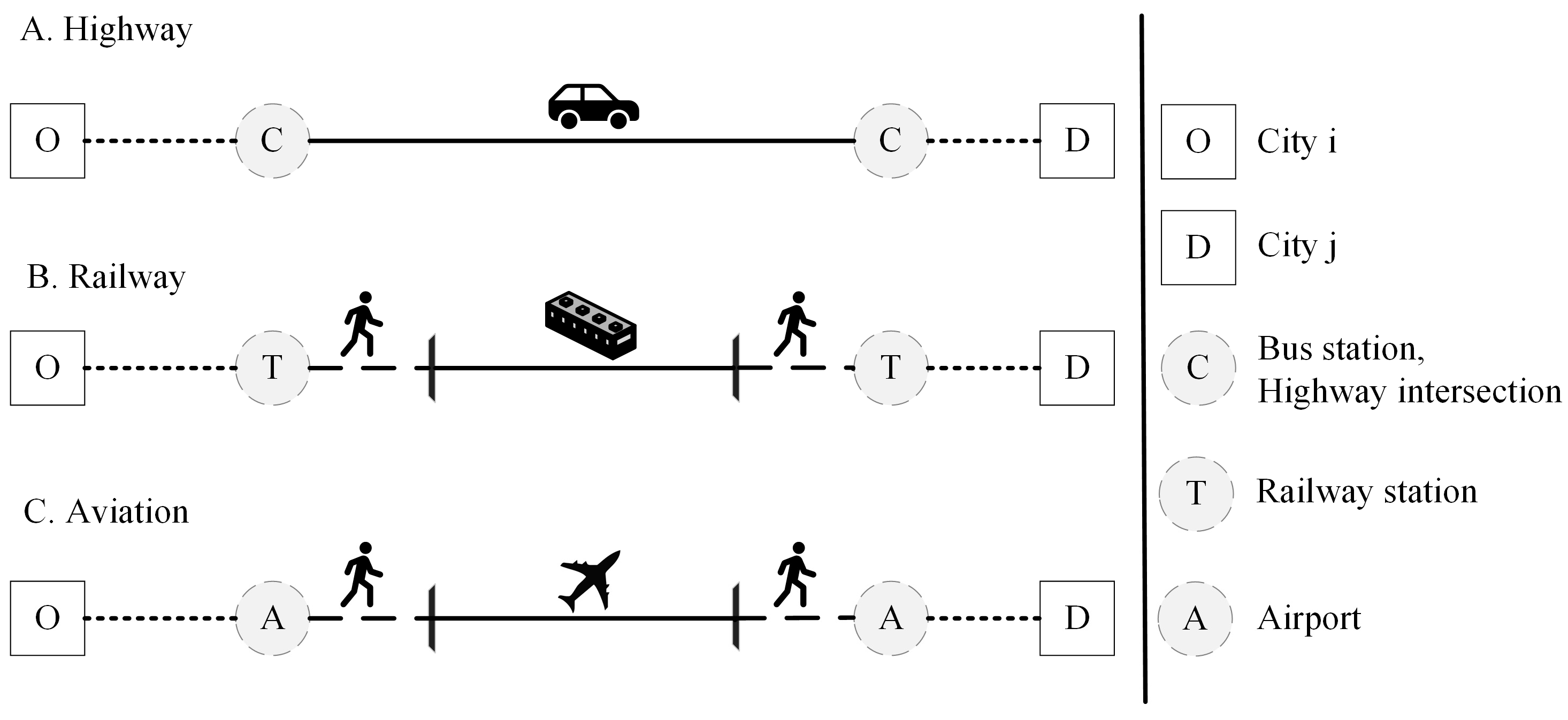
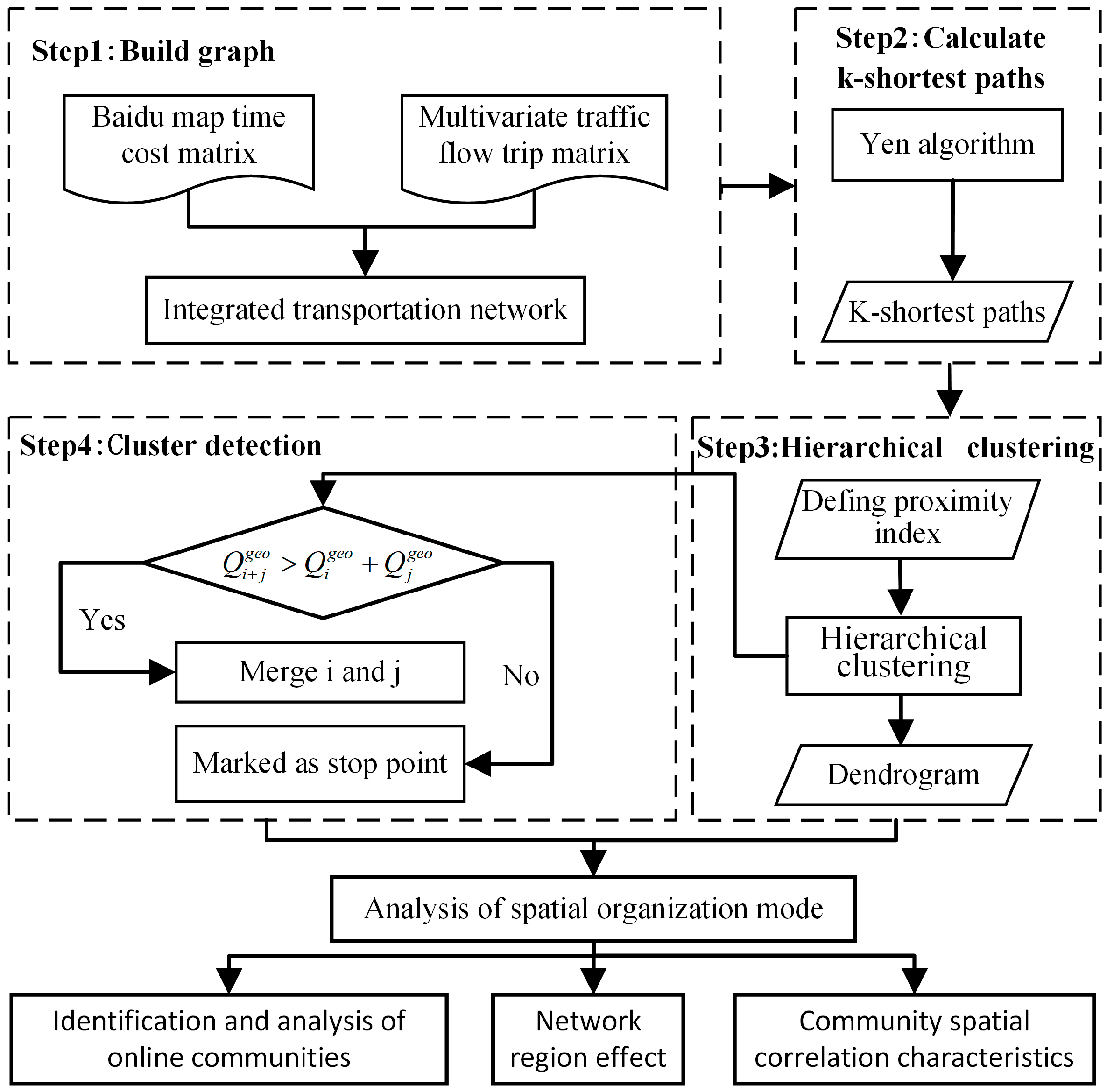







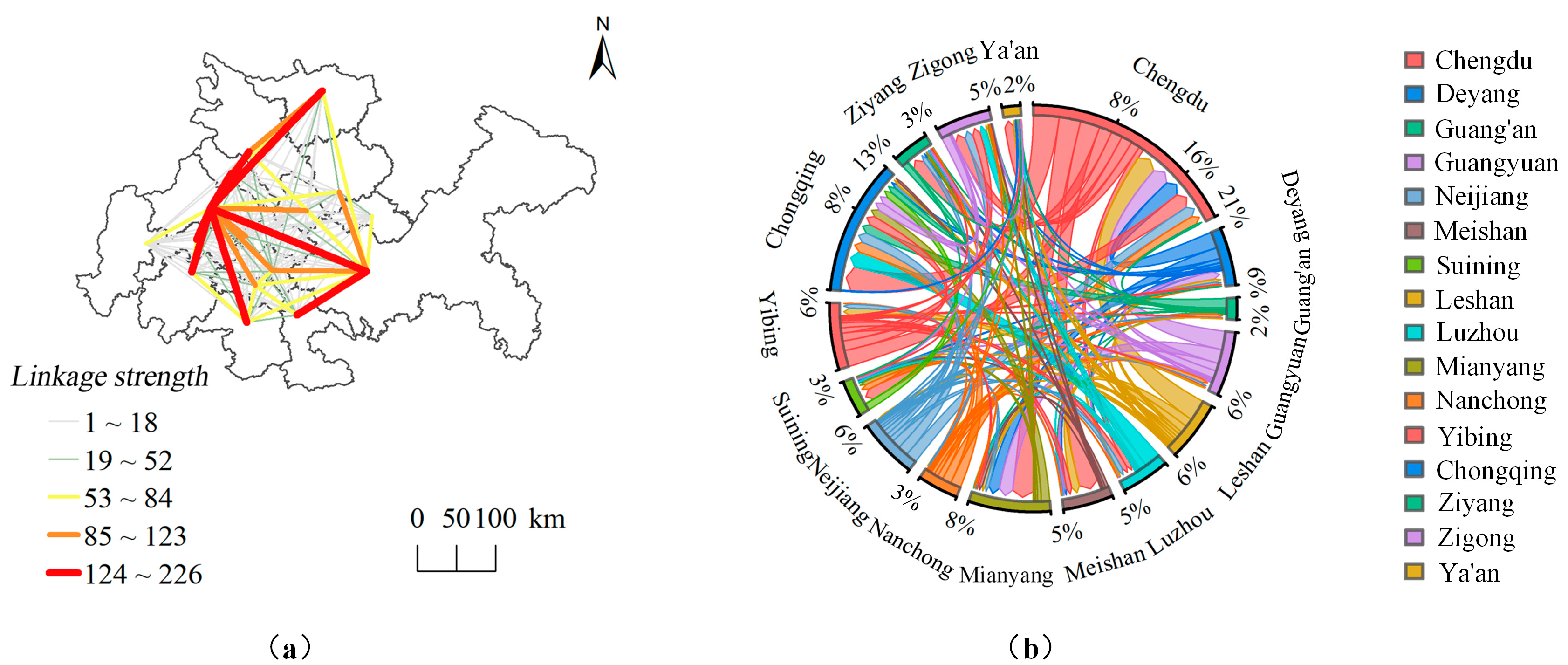
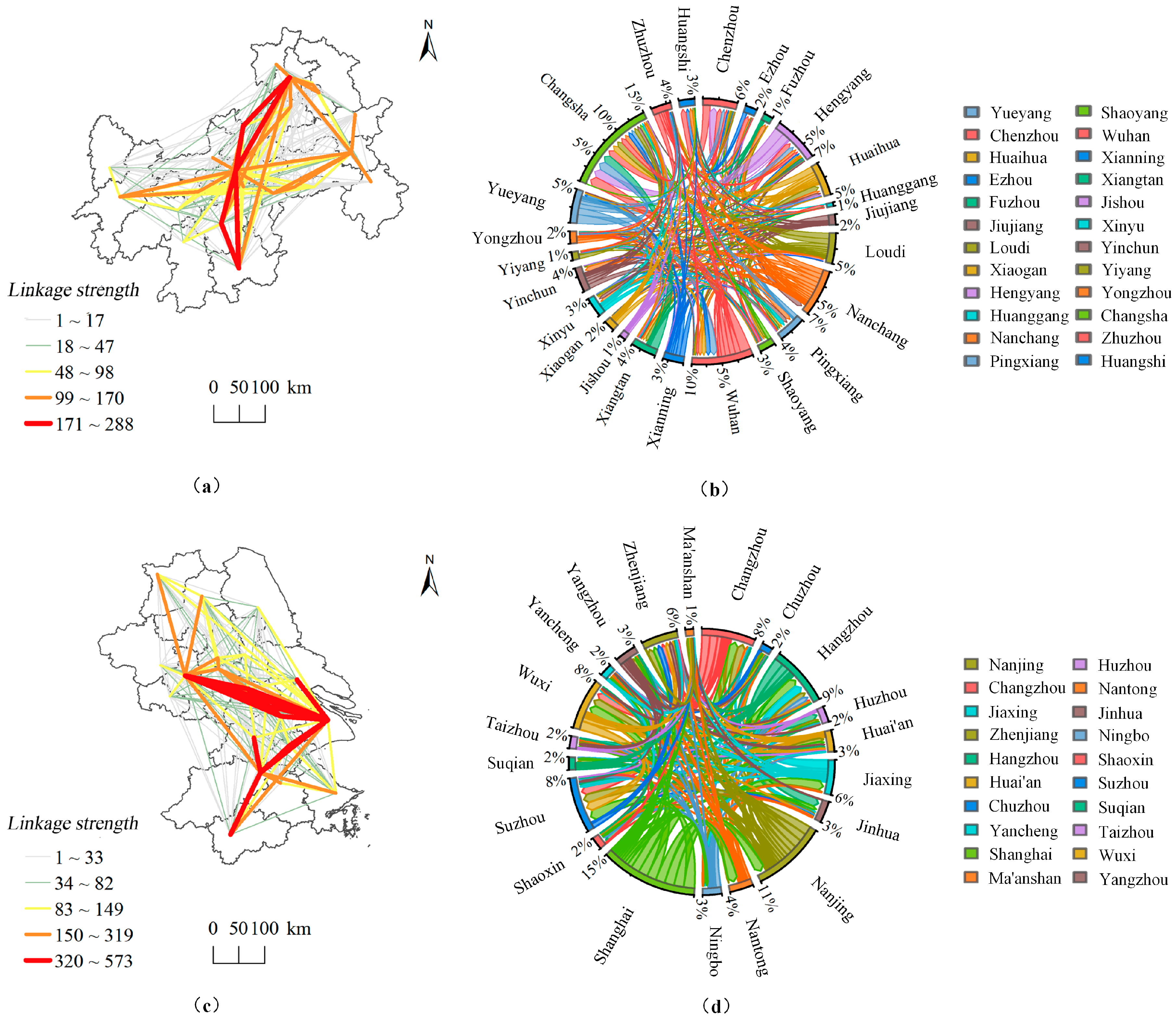
| Nodes | Total Links | Intra-Provincial Links | Inter-Provincial Links | Intra-Regional Links | Inter-Regional Links | |
|---|---|---|---|---|---|---|
| Highway | 128 | 3022 | 1231 | 1791 | 2136 | 886 |
| Railway | 121 | 5949 | 1097 | 4852 | 2838 | 3111 |
| Aviation | 70 | 946 | 66 | 880 | 236 | 710 |
Disclaimer/Publisher’s Note: The statements, opinions and data contained in all publications are solely those of the individual author(s) and contributor(s) and not of MDPI and/or the editor(s). MDPI and/or the editor(s) disclaim responsibility for any injury to people or property resulting from any ideas, methods, instructions or products referred to in the content. |
© 2024 by the authors. Licensee MDPI, Basel, Switzerland. This article is an open access article distributed under the terms and conditions of the Creative Commons Attribution (CC BY) license (https://creativecommons.org/licenses/by/4.0/).
Share and Cite
Liang, J.; Xie, S.; Bao, J. Analysis of a Multiple Traffic Flow Network’s Spatial Organization Pattern Recognition Based on a Network Map. Sustainability 2024, 16, 1300. https://doi.org/10.3390/su16031300
Liang J, Xie S, Bao J. Analysis of a Multiple Traffic Flow Network’s Spatial Organization Pattern Recognition Based on a Network Map. Sustainability. 2024; 16(3):1300. https://doi.org/10.3390/su16031300
Chicago/Turabian StyleLiang, Juanzhu, Shunyi Xie, and Jinjian Bao. 2024. "Analysis of a Multiple Traffic Flow Network’s Spatial Organization Pattern Recognition Based on a Network Map" Sustainability 16, no. 3: 1300. https://doi.org/10.3390/su16031300




